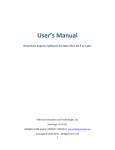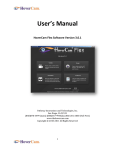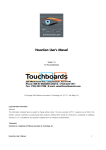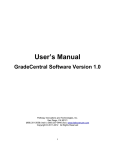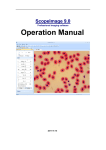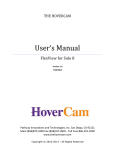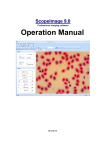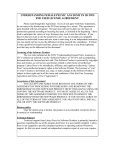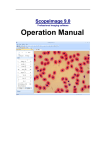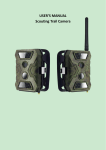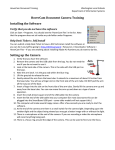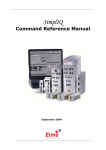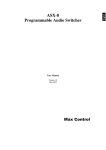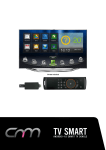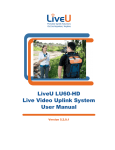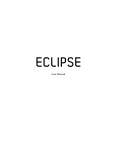Download View PDF
Transcript
User’s Manual HoverCam Flex Software Version 2.0.1 Pathway Innovations and Technologies, Inc. San Diego, CA 92121 (858)812-6358 (main) (858)357-9945(fax) www.thehovercam.com Copyright © 2010-2011 All Rights Reserved 1 Contents User’s Manual............................................................................................................................................. 1 HoverCam Flex Software Version 2.0.1........................................................................................... 1 Contents....................................................................................................................................................... 2 Support.................................................................................................................................................... 3 Unpacking Your HoverCam............................................................................................................. 6 Installation............................................................................................................................................. 7 Chapter 1 - Start Up............................................................................................................................ 8 Chapter 2 - Video Mode.................................................................................................................. 11 Chapter 3 – Scan Mode.................................................................................................................... 18 Chapter 4 – Archive Mode............................................................................................................. 22 Chapter 5 – Connect Mode (Experimental Feature)...........................................................24 Chapter 6 – Catapult (Drag-n-Drop into Another Program)...........................................25 Legal and Notice Information........................................................................................................... 26 2 Support We encourage you to read through this short User’s Manual to understand the HoverCam functionality. However, if an unexpected incident arises, please call us or submit a support ticket at http://www.thehovercam.com/support/ for a prompt and friendly reply. When contacting The HoverCam Support, please make sure to tell us your operating system, the HoverCam Model number, the problem you are experiencing, and as much contextual information as possible. You can alternatively email us at [email protected]. You can also call our main number (858) 812-6358 and ask for technical support. 3 System Requirements Host PC or Mac HoverCam T3, T5, Mini 3, and Neo 3 must work with a PC or Mac computer, with either the HoverCam Flex for Windows or HoverCam Express for Mac software installed and running. This means you need to connect the HoverCam to a host computer via USB 2.0 before video can be output to a projector or a TV Monitor from the host computer. In rare cases, certain projector products can take direct USB output from the HoverCam. We will inform you of those specific products on our web site when one becomes available. For now, assume you need to work with the HoverCam Flex software on a PC or HoverCam Express software on a Mac. If you are going to use the software on a computer that barely meets the minimum requirements, you may experience slow refresh rate. PC System requirements: Processor: Minimum: Intel Pentium III 1GHz or faster processor Recommended: Pentium 4 2GHZ or faster OS: Windows 2000/XP/2003, Windows Vista, Windows 7 RAM: Minimum: 1GB RAM; Recommended: 2GB RAM. Mac System Requirement: CPU: Intel Core 2 Duo 1.6Ghz or PowerPC RAM: 1GB OS: 10.5 or later Mac OS X10.4 or earlier versions is not supported due to the slow hardware on which the older OS versions run will not be able to handle high performance video. Projector or TV Monitor HoverCam Neo 5i and Neo 5p or other higher numbered models can output HD video directly to a projector. If the projector can handle HDMI input displaying minimum of 720P HD video, HoverCam has supplied a free HDMI cable for you. If the projector only takes VGA, or component or composite video input, HoverCam has also supplied the correct cables in the package. 4 Introduction The HoverCam is a new type of device. We say it is “more than a scanner, and more than a camera”. This means there are some new concepts when using the HoverCam. Live vs. Static Preview With the HoverCam, you get a live preview of the document under the camera. This means the document orientation can be adjusted in real time. You may place documents with various sizes freely. It is no longer necessary to wait for slowshowing static preview scans from a linear scanner. Snap-Shot vs. Scanning With the HoverCam, the entire page of a document is captured in a single snapshot. Expect that snapshot to finish within a split second. There is no mechanical sweeping action across of a scanning beam. If you are used to the long wait at a scanner, get ready for an instant change. Life-Like vs. Copier-Style Images With the HoverCam, the resulted image is a more accurate reproduction of the real document or 3 dimensional objects. Expect a life-like image that is significantly different from the carbon copy style of traditional scan images. USB Video The live video via USB can be used as a video presentation. This is an excellent solution for classroom instructors and visual presenters. The HoverCam is much more than just a scanner. Depth of Field The HoverCam lens offers a large depth of field, which makes it possible to take clear pictures even for scenes with multiple objects with varying heights or with a thick open book. 5 Unpacking Your HoverCam The contents of your HoverCam box will depend on which HoverCam you purchased. Please see the chart below to ensure that you received all items. HoverCam T5 HoverCam T5-V HoverCam T3 HoverCam Kudos 3 HoverCam X X X X Bumper X X Not included Not included USB Cable X X X X Carrying Pouch X X X Not included Mat X X X X Quick Start Guide X X X X Consult the Quick Start Guide for the best way to setup your HoverCam. Lay the mat flat where you intend to scan. Plug the USB cable provided into one of the USB ports on your computer. Plug the other end of the cable into your HoverCam. Unfold the HoverCam arm to begin scanning. 6 Installation You may need to download the HoverCam Software from the HoverCam website at http://www.thehovercam.com Windows users will use HoverCam Flex. Mac users will use HoverCam Express. Linux users could use open source software such as Cheese with their HoverCams. MSI An MSI is available on the HoverCam website for network administrators who want to install HoverCam Flex on several computers. TWAIN Driver for Windows Every time computer imaging software is used to access photos from a digital camera or images from a scanner, a TWAIN driver is in the background making it possible. The TWAIN driver that allows imaging software to understand the information located on an imaging device are a common part of a computer user's experience, yet often go unnoticed. Our TWAIN driver for Windows XP, 7 and Vista is available for download at http://www.thehovercam.com and allows programs that use a scanner to recognize your HoverCam as a scanner. Unlike other TWAIN drivers, the HoverCam can give you a real time video preview in HoverCam Flex to adjust, crop, straighten your image before scanning. Also, the TWAIN driver allows real time detection of the Bumper. The TWAIN driver will put a green frame along the inside edge of the bumper to more easily straighten documents. 7 Chapter 1 - Start Up FIGURE 1.1 Start Up Screen When you first start the HoverCam Flex Software, you will see the screen above. The four buttons show the major categories of tasks you may want to perform with the HoverCam. Video There is a simple rule of thumb whenever working with video: USB connection has limited bandwidth. The higher the resolution set for display, the lower the refresh rate. Unless you want to see a very sharp high-resolution image without the need to present under the camera, try lowering the camera resolution settings, and you will get higher refresh rate and a smoother motion in the video. In most cases, projectors used in classrooms or in corporate conference rooms have maximum resolution less than 1080P HD or 1920x1280. More often, projectors 8 only work at VGA or 1024x768 resolution. 720P or 1080P HD projectors tend to get very expensive very quickly. Because of this limitation from the projector device, when you are ready to do a video presentation, it is basically unnecessary to set the HoverCam at the highest resolution. Instead, you set the resolution lower to see a higher refresh rate. Thisis often more desirable than static image resolution. When you click on the “Video” button, you will be put into the “Video” Tab. Just follow the animated Startup Screen as it shrinks and “flies” to the “Video” Tab. Scan In “Scan” mode, the main goal is to capture a clear picture with the highest resolution possible, and then save the image to a file with the proper format The default resolution setting here is the maximum of the particular HoverCam model you purchased. Scan mode is also able to capture a straightened image with little or no warping or any other distortion. You will find the controls here developed by our engineers to make straightening simple. So, click on the “Scan” button, your HoverCam Flex screen will fly to the Scan Tab. Connect The HoverCam is more than a scanner. HoverCam is designed to let you connect with others to communicate ideas (such as a design blue print, a picture, a sketch, a note, a photograph, etc.). In Connect Mode, you can have 1-on-1 video conferencing sessions. Your screen can show your headshot along with your local document camera, and with your calling party’s headshot and the remote document camera. During the videoconference, you can annotate in real time over live video or a shared static image. We have also provided you with text chat and file transfer capabilities typically found in Skype, MSN Messenger, iChat, GoogleTalk, or AIM. Again, just click and “fly” over to Connect. Archive A “Library” was created to store and quickly find the documents or video that the user captured. In Archive Mode, the content of the “HoverCam Flex Library” folder that is under “My Document” directory is presented. What this means is a dedicated file manager for your Library collection of HoverCam captured images. Some predefined folders were created. You may also create new folders or shuffle files from folders to 9 folders. Feel free to delete them if they become irrelevant. Of course, you can also move the whole “Library” to a different path entirely. TIPS AND TRICKS Ever want to just drag an image and drop it into the application that you are using? You might have an Optical Character Recognition (OCR) reader, or you may be working on a PowerPoint presentation. Simply use your mouse, pick up a thumbnail, drag it out of the HoverCam Flex window (even when it is maximized), and discover how easy and fun it is. Drag-n-drop any thumbnail from virtually anywhere within HoverCam Flex. Keyboard shortcuts: try ctrl-c and ctrl-v on a captured image after entering an editing window. Just about everyone asked the question, “Can you scan a document straight into PDF?” The answer is “Yes.” Simply open the image and click on the “Create PDF” button at the top of the screen. Also, under the Tools menu there is a “Convert to PDF” menu item. You can save not only in PDF, but also in PNG, JPG, GIF, BMP, and TIFF. When you capture a time-lapse sequence, you can also save all the images into a single TIFF or a PDF file. There are some other fun things you can do in the Library as well. For example, converting any file into a PDF, export a file and save it with any format, upload a JPG image to Evernote, put something in your DropBox, or you can OCR an image then listen to the computer reading it back to you with Text-To-Speech (TTS). In the remaining chapters, every control in the software will be explained. We will present some use cases first, and then show you the solutions. 10 Chapter 2 - Video Mode Controls in the “Video” Tab FIGURE 1.2 Video Presentation Mode Screen 1. The “Video” Tab – Now you are in Video Presentation Mode. 2. Select the video resolution. 3. Adjust “Brightness”. 4. Adjust “Saturation”. 5. Adjust “Contrast”. 11 6. Rotate 90 degrees left. 7. Rotate 90 degrees right. 8. Zoom Out by approximately 5%. 9. Zoom Slider Control. Keep in mind, the FASTER way to zoom is to move the Mouse Wheel. 10. Zoom In by approximately 5%. 11. Show Actual Size of the Image, or 1:1 ratio. 12. Scale the Image to fit into the current window. 13. Enter Full Screen Mode. 14. Freeze Frame and Resume Live Video. 15. Record Video. 16. Enter Picture-In-Picture Mode. 17. Show or hide Annotation Toolbar. 18. Tools Menu to select settings, set file path, and check for auto updates. 19. Search files by file names. 20. Select Camera Device. 12 FIGURE 1.2 Annotation Tool Bar in Video Presentation Mode 21. Disable Annotation Pointer Action. 22. Select Pointer Operable on Annotation Objects (such as select and move an annotation mark). 23. Free Hand Drawing Tool 24. Line Drawing Tool 25. Arrow Line Drawing Tool 26. Mask Tool 27. Rectangle Drawing Tool 13 28. Oval Drawing Tool 29. Fill Tool 30. Text Box Tool 31. Eraser Tool, X sign for deleting one annotation mark. 32. Clear All Annotation. 33. Color Selector 34. Line Thickness Selector 35. Transparency Setting 36. Font Setting What Can You Do and How To Use the Software to Do it? 1. Select Camera Device The drop down list (20) lets you select from a list of recognized camera devices. This will display your HoverCam camera if a HoverCam is present and any other cameras (such as a built-in web cam). 2. Change Video Resolution Use control (2) to set the video at various resolutions. By default, the HoverCam shows video at 4:3 ratio. The maximum is set to be 1600x1200 or UXGA resolution with refresh rate of 12 to 15 frames/second. When resolution is lowered to 640x480, there is less data being captured across the USB and the refresh rate can reach 30 frames/second. 3. Digital Zoom In/Out Anytime your cursor is inside of the HoverCam Flex display window, you may use the mouse wheel’s movement to zoom in or zoom out on the objects displayed. Alternatively, you can use the slide bar controls (8), (9), and (10) to resize the video. 4. Refocus in an Area This is essentially to display a portion of the full image while zoomed in. Use the mouse to “drag” the display area in the window. 14 5. Annotate Live Video If you click the “Annotate” button (17), an Annotation tool bar will appear on the right side of the screen. For a reference of all Annotation Controls, see FIGURE 1.2. 6. Enter Full Screen Mode By clicking on (13) Full Screen Control, the video display will take up the entire monitor screen. This is often very helpful for showing a maximized surface area. You can exit Full Screen Mode at any time by hitting the “ESC” key. Moving your mouse cursor near the bottom will bring up the same control bar found in normal display mode. You can perform all the functions that appear normally, such as taking a snapshot, in Full Screen Mode. Annotation in Full Screen Mode is also enabled. 7. Adjust Image Effects Image Brightness, Saturation, and Contrast can be changed on screen using controls (3), (4), and (5). However, these adjustments are digital effects implemented in software after the imaging in the camera devices is completed. Adjusting ambient lighting conditions for the camera is still the best way to achieve good image quality. 8. Rotation Images can be rotated in 90 degree increments in either counter clockwise or clockwise directions using controls (6) and (7). 9. Freeze a Frame Clicking on control (14) let you freeze the video at the current frame. This is useful when a teacher want to avoid causing dizziness in kids while turning a page or shuffling materials under the camera. It is also often desirable to annotate a frozen frame using the on screen annotation tools. 10. Annotate with a Pen on the Paper With the live video preview, you can annotate in front of an audience by writing directly on the document under the camera. In this mode, you want to lower the video resolution to achieve higher refresh rate. 15 11. Show Picture-in-Picture When sharing your entire screen with a contact on Skype, WebEx, or GoToMeeting, it can be helpful to show a picture of yourself and a picture of the subject of discussion. Simply press on the PIP button (16) to bring out the second (smaller) window. In the secondary PIP window, when move mouse cursor over the window, you will see the above control bar appear. The very left button let you swap the video in the two windows. The very right button with a gear icon let you change the settings. Here, you can select a different camera device for the video display in the second window. The rotation buttons are self explanatory. Notice that you can’t change the camera selection in the second window if both windows are displaying videos and there are only two cameras available. When both cameras are selected already, the only option is to swap windows. 12. Record a Video By pressing the Record button (15), a new window will pop up, in which a new preview video is shown. Please press the Record button in the new window one more time to start the recording process. All recordings are saved as AVI files. To return back to the previous window, you will need to close the pop up window. 13. Select the Best Display Size Selecting a resolution of 800x600 will ensure refresh rate of 25 fps, allowing for a balance between clarity and smooth video. 640x480 (VGA) resolution will give you 30 fps but visibly reduced clarity. When you select 1024x768, 16 frame rate is likely to be at 17fps. Here you will get very good clarity while sacrificing somewhat in refresh rate. 14. Change File Save Path You can change the default path for the “HoverCam Flex Library” folder, where all the captured images are kept by default. The “HoverCam Flex Library” is a regular folder in the user’s home directory, normally under “My Documents”. If you would like to move it to a different location, just make sure it is a path where you don’t have permission issues. On Windows 7, saving application files/data under “c:\Program Files” is prohibited now. 15. Change Naming Convention Scanned images are saved according to a naming convention, by default as “img_” followed 4 digits of numbers starting at 0001. You can change the initial name to something other than “img_” by selecting “Tools->Naming Convention->Customize”. You may also change the names in batch later on by selecting a group of files in the HoverCam Library by right clicking on multiple selected files and select “rename”. You will be able to rename files following the same naming convention rules. To change file names to an arbitrary one, you will need to change one file name at a time, by right clicking on the individual file and select “rename”. 17 Chapter 3 – Scan Mode Scan Mode Controls FIGURE 3.1 The Scan Mode Screen 1) Action Panel within the Scan Mode screen, where all the controls are placed. 2) Library Panel to bring up the current path for saving files . 3) Resolution Selection Dropdown List. 4) File formats which scanned images can be saved in. 5) Compression Quality: “Good” means less compression. 6) Brightness Control Slider. 7) Color Saturation Control Slider. 8) Contrast Control Slider. 18 9) “Remember Settings” for all future scans. 10) Straightening Adjustment (includes slider ranging from -15 to +15 degrees, and +/- controls with 0.5 degree increments) 11) “Auto” Straightening (only activated when “Use Bumper” is checked.) 12) “Use Bumper” Checkbox for using the Anchoring Bumper as a straightening aid. 13) Cancel all previous rotation/straightening adjustment. 14) Show cropping window (it is the same window used in straightening)-cropping result follows the rule of WYSWYG (What You See is What You Get). 16) Rotate 90 degrees counter clockwise. 17) Rotate 90 degrees clockwise. 18) Zoom In or Zoom Out Slider Control, which includes the +/- controls for 5% increments. Rotate the mouse wheel forward or backward is equivalent to moving the slider right or left. 19) 1:1 shows the video in actual size. 20) Fits video preview frame to the current window size. 21) Enter or exit Full Screen Mode. 22) Freeze Frame Control. 23) Show Picture-in-Picture Mode. 24) “Scan” or “SnapShot” Button. 25) Capture Time Lapse Images or Auto Capture Multiple Images. 26) Turn Annotation On or Off. 27) Tools Pull Down Menu. 28) Search keys in file names (currently searching is only limited to image file names). 29) Camera Selection Dropdown List. Scan Mode Software In Scan Mode, our focus is to capture the sharpest image of a document. The unwanted edges trimmed are off and the page are straightened. The HoverCam captures the image with color, making the result more life-like compared to 19 traditional flatbed scanners which tend to produce more high contrast black-andwhite images. The quality of color reproduction by the HoverCam depends on the ambient lighting condition. The best environment for “scanning” with the HoverCam is where there is in a room with even fluorescent lighting. The Anchoring Bumper The Anchoring bumper has two main functions: Auto-Straightening and Quick MultiCapture. Auto-Straightening When placed against one corner of a document, it serves as a guide for the software to calculate the amount of skewing of the document image so that the image can be straightened automatically. To do this, position the HoverCam over the positioning mat. Put the bumper against one corner of a document and place both on top of the positioning mat. In HoverCam Flex, check “Use Bumper” and then click on “Auto”. You should have a straightened image with a default sized cropping window. If you would like to fine tune the straightening manually on top, use the slider control or with the “+”/”-“ signs to adjust. Resize or move the cropping window to desirable size or location, then “snap”. You should get a WYSWYG image. Figure A. Align the bumper with one of the edges of your document. 20 Figure B. Check Use Bumper and Auto to have HoverCam Flex straighten the document automatically. Quick Multi-Capture The soft and non-slippery bottom tends to bond with the positioning mat to maintain a stationary bumper position for multiple sheets of paper. This ensure that once a document is straightened and properly cropped in the preview window, more sheets of documents can simply be stacked on top for capturing with the same straightening and cropping settings without any additional calibration. To use this function of the bumper, you only need to stack more paper against the bumper on top of the first one, or replace the first sheet with a new sheet, or remove the top sheet from a stack of paper, then “snap”. You will get a WYSWYG image. Scan Mode Software Functions: • • • • • • • • • • • • Cropping Straightening Saving in Selected Formats Setting the Resolution Setting the Compression Quality Adjusting Brightness, Saturation, and Contrast Annotate and Capturing Annotation in a Scan Capture a Face Shot with a Document Auto Capture of Multiple Document Images Exporting Images Out Find Images in the Library Edit Images 21 Chapter 4 – Archive Mode The Archive Screen and Controls What Can You Do In Archive Mode? The Archive Mode answers the question, “I have scanned a document. Now what?” You should be able to do all the usual operations on the scanned images: • • • • • • Edit them. Organize them into folders. Collate them into Binders. Convert one or multiple images into a single PDF file. Convert Image formats. Drag them out of HoverCam Flex and into any other application you use. • • • • Change their names. Delete one or multiple of them. Print them. Email them out as attachments. • Export and save them with different file format and names. 22 We put in a few advanced features beyond the normal functions as well: • • • • OCR – You can activate Optical Character Recognition on a scanned image of handwritten, printed or typed text and the HoverCam Flex will translate the scanned images into machine-encoded text. Click on the button below the text and the HoverCam Flex will read a document back to you using text-to-speech (TTS). Digital Signature – When you enable Signature in the HoverCam Flex you will be prompted to create a password. You then sign a digitally scanned document and can use that scan to sign any other document digitally with your own handwriting. As this signature is password protected, only you will have access to it. Cloud Services – You can quickly and easily upload your scanned images to the most popular cloud services, such as Evernote, Picasa Web Album, and Dropbox. Stacking – The Stack icon at the top of HoverCam Flex Archive allows you to stack a series of images to create one file. This has a variety of uses such as for convenience in emailing or to create a booklet of your scanned documents. When stacking with image files, you can use the Sorter that will appear to the left to re-order the images in your stack. However, you will not be able to re-order in this way once your images have been converted into PDF format. If you want to make a PDF booklet, be sure to put your stack in the proper order before converting the images to PDF. 23 Chapter 5 – Connect Mode (Experimental Feature) This new feature will allow HoverCam users to other and share annotated video conferences whenever they wish connect with each. Connect Mode allows HoverCam users to share not only the image that the HoverCam is currently capturing but also an image of the other user. In this manner, two users can talk face-to-face while sharing documents, plans, or anything else under the HoverCam. To start a HoverCam Connect session, just enter a valid email address as your ID. Then share that ID with a friend who can enter the ID to call you. If you know your friend's ID, enter that ID to start the call. 24 Chapter 6 – Catapult (Drag-n-Drop into Another Program) Catapult is a unique function in HoverCam Flex that allows you to drag and drop an image directly into another program such as an interactive white board. To use catapult, you will need a scanned image. In Video or Scan mode, click on and hold an image to drag and drop the image to any edge of the screen. The result of catapult depends on where you release the image. Catapult can only be used with static images. 25 Legal and Notice Information Warranty The information contained herein is subject to change without notice. The only warranties for P.I.T. products are set forth in the express warranty statements accompanying these products. Nothing herein should be construed as constituting an additional warranty. P.I.T. Is not liable for any technical or editorial errors or omissions contained herein. Trademarks HoverCam is a registered trademark of Pathway Innovation & Technology, Inc. Intel is a registered trademark of Intel Corporation. EverNote is a registered trademark of EverNote Corporation. Dropbox is a registered trademark of Dropbox, Inc. Macintosh, iMovie, PhotoBooth and iChat are registered trademarks of Apple, Inc. Windows Vista, Windows XP and Windows Live Messenger are registered trademarks of Microsoft, Inc. Skype is a registered trademark of Skype Limited. AOL is a registered trademark of America Online, Inc. Google Talk is a trademark of Google Inc. End-User License Agreement (EULA) This copy of HoverCam Flex ("the Software Product") and accompanying documentation is licensed and not sold. This Software Product is protected by copyright laws and treaties, as well as laws and treaties related to other forms of intellectual property. Pathway Innovations & Technologies, Inc. or its subsidiaries, affiliates, and suppliers (collectively "P.I.T.") own intellectual property rights in the Software Product. The Licensee's ("you" or "your") license to download, use, copy, or change the Software Product is subject to these rights and to all the terms and conditions of this End User License Agreement ("Agreement"). Acceptance YOU ACCEPT AND AGREE TO BE BOUND BY THE TERMS OF THIS AGREEMENT BY SELECTING THE "ACCEPT" OPTION AND DOWNLOADING THE SOFTWARE PRODUCT OR BY INSTALLING, USING, OR COPYING THE SOFTWARE PRODUCT. YOU MUST AGREE TO ALL OF THE TERMS OF THIS AGREEMENT BEFORE YOU WILL BE ALLOWED TO DOWNLOAD THE SOFTWARE PRODUCT. IF YOU DO NOT AGREE TO ALL OF THE TERMS OF THIS AGREEMENT, YOU MUST SELECT "DECLINE" AND YOU MUST NOT INSTALL, USE, OR COPY THE SOFTWARE PRODUCT. 26 License Grant This Agreement entitles you to install and use one copy of the Software Product. In addition, you may make one archival copy of the Software Product. The archival copy must be on a storage medium other than a hard drive, and may only be used for the reinstallation of the Software Product. This Agreement does not permit the installation or use of multiple copies of the Software Product, or the installation of the Software Product on more than one computer at any given time, on a system that allows shared used of applications, on a multi-user network, or on any configuration or system of computers that allows multiple users. Multiple copy use or installation is only allowed if you obtain an appropriate licensing agreement for each user and each copy of the Software Product. Restrictions on Transfer Without first obtaining the express written consent of P.I.T., you may not assign your rights and obligations under this Agreement, or redistribute, encumber, sell, rent, lease, sublicense, or otherwise transfer your rights to the Software Product. Restrictions on Use You may not use, copy, or install the Software Product on any system with more than one computer, or permit the use, copying, or installation of the Software Product by more than one user or on more than one computer. If you hold multiple, validly licensed copies, you may not use, copy, or install the Software Product on any system with more than the number of computers permitted by license, or permit the use, copying, or installation by more users, or on more computers than the number permitted by license. You may not decompile, "reverse-engineer", disassemble, or otherwise attempt to derive the source code for the Software Product. Restrictions on Alteration You may not modify the Software Product or create any derivative work of the Software Product or its accompanying documentation. Derivative works include but are not limited to translations. You may not alter any files or libraries in any portion of the Software Product. Restrictions on Copying You may not copy any part of the Software Product except to the extent that licensed use inherently demands the creation of a temporary copy stored in computer memory and not permanently affixed on storage medium. You may make one archival copy which must be stored on a medium other than a computer hard drive. 27 Disclaimer of Warranties and Limitation of Liability UNLESS OTHERWISE EXPLICITLY AGREED TO IN WRITING BY P.I.T., P.I.T. MAKES NO OTHER WARRANTIES, EXPRESS OR IMPLIED, IN FACT OR IN LAW, INCLUDING, BUT NOT LIMITED TO, ANY IMPLIED WARRANTIES OF MERCHANTABILITY OR FITNESS FOR A PARTICULAR PURPOSE OTHER THAN AS SET FORTH IN THIS AGREEMENT OR IN THE LIMITED WARRANTY DOCUMENTS PROVIDED WITH THE SOFTWARE PRODUCT. P.I.T. makes no warranty that the Software Product will meet your requirements or operate under your specific conditions of use. P.I.T. makes no warranty that operation of the Software Product will be secure, error free, or free from interruption. YOU MUST DETERMINE WHETHER THE SOFTWARE PRODUCT SUFFICIENTLY MEETS YOUR REQUIREMENTS FOR SECURITY AND UNINTERRUPTABILITY. YOU BEAR SOLE RESPONSIBILITY AND ALL LIABILITY FOR ANY LOSS INCURRED DUE TO FAILURE OF THE SOFTWARE PRODUCT TO MEET YOUR REQUIREMENTS. P.I.T. WILL NOT, UNDER ANY CIRCUMSTANCES, BE RESPONSIBLE OR LIABLE FOR THE LOSS OF DATA ON ANY COMPUTER OR INFORMATION STORAGE DEVICE. UNDER NO CIRCUMSTANCES SHALL P.I.T., ITS DIRECTORS, OFFICERS, EMPLOYEES OR AGENTS BE LIABLE TO YOU OR ANY OTHER PARTY FOR INDIRECT, CONSEQUENTIAL, SPECIAL, INCIDENTAL, PUNITIVE, OR EXEMPLARY DAMAGES OF ANY KIND (INCLUDING LOST REVENUES OR PROFITS OR LOSS OF BUSINESS) RESULTING FROM THIS AGREEMENT, OR FROM THE FURNISHING, PERFORMANCE, INSTALLATION, OR USE OF THE SOFTWARE PRODUCT, WHETHER DUE TO A BREACH OF CONTRACT, BREACH OF WARRANTY, OR THE NEGLIGENCE OF P.I.T. OR ANY OTHER PARTY, EVEN IF P.I.T. IS ADVISED BEFOREHAND OF THE POSSIBILITY OF SUCH DAMAGES. TO THE EXTENT THAT THE APPLICABLE JURISDICTION LIMITS P.I.T.'S ABILITY TO DISCLAIM ANY IMPLIED WARRANTIES, THIS DISCLAIMER SHALL BE EFFECTIVE TO THE MAXIMUM EXTENT PERMITTED. Limitation of Remedies and Damages Your remedy for a breach of this Agreement or of any warranty included in this Agreement is the correction or replacement of the Software Product. Selection of whether to correct or replace shall be solely at the discretion of P.I.T.. P.I.T. reserves the right to substitute a functionally equivalent copy of the Software Product as a replacement. If P.I.T. is unable to provide a replacement or substitute Software Product or corrections to the Software Product, your sole alternate remedy shall be a refund of the purchase price for the Software Product exclusive of any costs for shipping and handling. 28 Any claim must be made within the applicable warranty period. All warranties cover only defects arising under normal use and do not include malfunctions or failure resulting from misuse, abuse, neglect, alteration, problems with electrical power, acts of nature, unusual temperatures or humidity, improper installation, or damage determined by P.I.T. to have been caused by you. All limited warranties on the Software Product are granted only to you and are non-transferable. You agree to indemnify and hold P.I.T. harmless from all claims, judgments, liabilities, expenses, or costs arising from your breach of this Agreement and/or acts or omissions. Governing Law, Jurisdiction and Costs This Agreement is governed by the laws of California, without regard to California's conflict or choice of law provisions. Severability If any provision of this Agreement shall be held to be invalid or unenforceable, the remainder of this Agreement shall remain in full force and effect. To the extent any express or implied restrictions are not permitted by applicable laws, these express or implied restrictions shall remain in force and effect to the maximum extent permitted by such applicable laws. 29





























